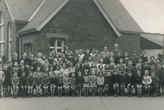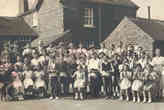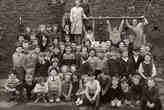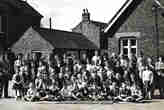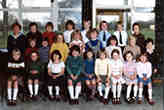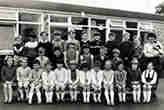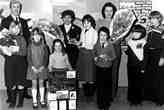A History of Eastrington School
The present Eastrington school was built in 1964/5 to replace the old 'board school' on Queen Street. This school had opened on January 20th 1879 and was designed to accommodate 110 children in two classrooms. The board school had in turn replaced a National school, built in 1846 on the same site and that had replaced a thatched building given to the village as a school by Joseph Hewley in 1726.
The 'old' school had an extra classroom built in 1898 - the 'infants room' - and the canteen was opened in September 1945. Teachers have come and gone - headmasters such as Mr Freer, Mr Etherington, Mr Bramley, Mr Garbutt, Mr Thomas and Mr Coates, who oversaw the move from old to new school - and classroom teachers such as Miss Botterill, Mrs White, Mrs Leadill and Mrs Watson.
At one time in the 1930s the school had its own magazine and even a school song to give pupils a pride in their school and village:
The school song
Life lies before us, all the earth
Before our feet is spread.
Ours is the future, our true worth
Will form the years ahead.
All time, all space our minds may roam
But present tasks are nearer home.
Eastrington, our village, our home, our school,
Our daily task, our work, our play
fill every hour yet while we may.
Let all strive paltry self to rule
And seek to serve our Eastrington.
For by our work and by our play
And by the tasks we do
Our characters are formed today,
Our aims and habits too.
Our hopes and purposes will grow
To noble ends if fashioned so
Eastrington, our village, our home, our school.
Below are a few pictures of former classes. Click on these and you will find a larger version with names attached. If you have any further memories of Eastrington school 'in the old days' or any more old photos, please do get in touch!
There is also a gallery of old photographs of the Howden and Goole area including many old pictures of Eastrington and of other local villages such as Gilberdyke and Laxton.
I have included below my own memories of Eastrington school below:
Eastrington school in the 1950s
I went to school in what is now known as the old school beginning when I was four or five in the mid-1950s. The infants teacher was Mrs White and she seemed quite strict to me. The infants' room (until fairly recently used for playgroup) always smelled of chalk and plasticine. At one end was the Wendy house and our tables and chairs were at the other, nearest the canteen. The room was heated by a coke stove with a big guard around it. Lessons I remember were playing with plasticine while Mrs White did the registers, writing in a diary using wax crayons (I seem to remember the pages were black or grey paper) and doing sums in a small brown book printed in squares.
Playtime was a time to visit the lavatories which were across the yard. They had blue wooden doors and inside were wooden seats with a galvanised bucket underneath. At the end of playtime we had to line up outside our classroom when the teacher blew the whistle. I remember earning a sharp smack for pulling the plaits of the girl in front who was called Jill Daniels.
After the infants I moved into the main schoolroom into Mrs Leadill's class. This was the end nearest the road and was divided from the top class by a folding wooden partition. I remember many spelling tests and doing sums from cards which were stored in a maroon box. You worked your way through one card, had the sums marked and then were allowed to put that card back and get another one. It took a long time to do a card as there were about a hundred sums on each one. I sat with Keith Holmes and I remember how we wondered if anybody ever finished those cards.
Another memory of Mrs Leadill's class is the taste of warm milk. The crates of milk were often put near the stove to warm up in winter and at the end of the afternoon there were often a few bottles left from the morning distribution. These were offered around just before 'hometime' and I can still conjure up the warm, sickly taste. This 'taste' is always linked in my mind with the hometime prayer which we always chanted, often at speed before being dismissed at half past three. 'Lord keep us safe this night, secure from all our fears; may angels guard us while we sleep, till morning light appears. Amen.'
When I was seven or eight I moved into the headmaster's class on the other side of the partition. He was called Mr Thomas, invariably wore thick patterned woollen sweaters and had a very fierce temper. He lived with his wife in the schoolhouse. We never saw much of her but she was a potter and once made a beautiful pottery model of our Basset hound, Juno. I remained in this class for three years, spending a lot of the time making beautifully illustrated projects. I dreaded making the covers for these which had to be designed and each letter laboriously measured, often taking several afternoons to complete. We also had to draw borders half an inch wide round each piece of paper we wrote on and pencil lines half an inch apart. Then Mr Thomas dictated the contents of the booklet very slowly to the whole class. These booklets were displayed on the walls of the partition and no doubt impressed inspectors but I can recall even now the mind-numbing boredom of producing them. However, we did do some pottery and we were all very proud of our mugs which we made with our own names on and which were fired in Mrs Thomas' kiln. I still have mine.
We also did a lot of playground games with Mr Thomas and I can still remember the excitement of games of 'tunnel ball' last thing on a summer afternoon. Sometimes on a Wednesday afternoon we all trooped through the village to the playing field and played rounders or cricket. In the playground we played whatever games were in season. Whips and tops were popular until some children, including my cousin Richard, obtained what were called 'windowbreakers' and then they were all banned. We played conkers and marbles and then came 'hula hoops'. These were for girls and came in bright colours although I could never make mine do all the wonderful things that you were supposed to.
Also for girls were ball games such as 'sixes' against the little classroom wall and of course skipping. We borrowed one of the long ropes from the gym shed; turning it was hard as it stretched half way across the playground. The rhymes were largely traditional: 'Salt, mustard, vinegar, pepper'; 'All in together girls, this fine weather girls'; 'Nebuchadnezzar was king of the Jews, Bought his wife a pair of shoes, When the shoes began to wear, Nebuchadnezzar began to swear'; 'The big ship sailed down the illy ally oh' and 'Solomon Grundy'. There was also a rhyme based on the months where you were supposed to jump in on your birthday month and out again when it came round the second time. I could never do this and usually stopped the rope. Both boys and girls played 'block', 'tig', 'off ground tig' and leapfrog. There was a climbing frame in the playground near the side wall which separated us from Mr and Mrs Roy Wraith's yard which would probably have been condemned as dangerous today. It was well used and girls used to compete to 'hang by their benders' from the top bar. Some did fall off and had ocasionally to be taken to hospital but I don't remember too many accidents apart from when my cousin Richard cut his knee on the square wire litter bin.
We also played at being the 'nit nurse' or 'dicky nurse' when inspired by one of her visits. These visits, by Nurse Jenkinson I think, were quite frequent and although the staff tried to be discreet it was always fairly obvious who had been discovered to have 'nits' by their immediate disappearance after being inspected behind the curtained door of the small classroom. I think we all had them at one time or another.
There was a canteen at the school and although I usually went home for dinner I did stay sometimes. The dinners were very good and cost a shilling. On Tuesday and Thursday afternoons my mother, Mrs Watson, came to teach music. We sang to Singing Together on the radio once a week and practised the songs from the white pamphlets during the lessons. We also sang from the red-backed national song book - songs such as Tom Bowling, The Mermaid, Molly Malone or The Minstrel Boy which seemed to involve lots of tragic deaths often at sea, or rousing songs such as the Song of the Western Men or Hearts of Oak. These lessons took place in the canteen and I associate them and the noise of squeaky recorders with the lingering smell of dinner and plastic beakers.
At Christmas there was always a carol service in the church and, later in the week, a party in the main classroom. The wooden partition was folded back and all the children wore their party clothes. Those who could not go home to get changed at dinnertime went to a friend's house in the village. There were the usual games and then we went across the playground to the canteen for tea. This was always very exciting because it was dark and sometimes snowing. We ate potted meat and egg sandwiches and jelly and sometimes icecream Then after tea came the best part of the whole event. The man with the cartoons came and set up his projector in the canteen.We all sat enraptured through a selection of films, the best of which was always 'Woody Woodpecker'.
When I was ten I had, like everybody in the top year, to spend a Tuesday and Thursday morning doing two tests to see which school I would go to next. All the other children in the school came to school late that morning so that we were not distracted by them. I passed and went to Goole Grammar School in September. Most of the rest of my year stayed at Eastrington for an extra term as the new secondary school at Howden was not quite ready and they would not be going until January. At the end of the Christmas term I remember going back to the party in the canteen but it wasn't the same. I was different now and went to the grammar school.

